This monitoring period covers the harvests of wheat in July and August, followed by maize in September and October. Winter wheat sowing started in September.
本监测期包含了小麦(7月和8月)和玉米(9月和10月)的收获期,以及冬小麦的翻耕播种期(9月份开始)。
According to the agroclimatic and agronomic indicators of CropWatch, this season in Ukraine was drier than usual, rainfall was 15% less, temperature was 0.6℃ lower than the 15YA, and sunshine reached 998 MJ/m² (+4%). Nearly all cropland was cultivated (CALF reached 99%, +4%), cropping intensity was at 123% (+19%) and maximum vegetation condition index (VCIx) was 0.95, which indicated the conditions for the crops were favorable. Estimated biomass (BIOMSS, 610 g DM/m², -4%) at the national level was slightly below the 15YA.
根据CropWatch农情及农气指标,乌克兰本季的气候条件较正常情况干燥,与15年平均水平相比降水偏低15%,温度偏低0.6℃,光合有效辐射达到了 998 MJ/m² (偏高4%)。基本上所有的耕地都已耕作(CALF值达到了99%,偏高4%),复种指数为123%(偏高19%),最佳植被状况指数(VCIx)为0.95,上述指标表明作物长势较好。预计全国尺度上的潜在生物量(BIOMSS)将较15年平均水平略微偏低4%(达到610 g DM/m²)
During this period, NDVI at the national level was generally above the 5YA, even exceeding the 5-year maximum before October. As shown in the spatial NDVI patterns, NDVI in about 85.8% area of cropland was above or close to the 5YA until September. However, an obvious depression of NDVI was observed in middle October, which could be attributed to the rainfall deficiency in October. Time series of rainfall profile suggested the amount of precipitation was less than one-third of the 15YA in this month and the proportion of drought area had risen to 40% accordingly. Spatial VCIx pattern showed crop conditions in most croplands of Ukraine were good (VCIx was between 0.8 and 1), especially favorable in Donetsk, Crimea and Odessa region.
监测期内全国尺度上的NDVI总的来说高于5年平均水平,在10月内甚至超过了5年最大值。NDVI聚类空间分布图显示,从监测期开始直到9月,大约85.8%耕地的NDVI高于或接近5年平均水平,但受10月份严重缺雨的影响,NDVI在10月中旬显著偏低。降水的时间序列过程图也表明10月份降水不及15年平均水平的三分之一,全国干旱区域的比例相应上升至40%。最佳植被状况指数空间分布显示,乌克兰大部分农田的作物长势良好(VCIx介于0.8和1之间),尤其是顿涅斯克、克里米亚以及敖德萨地区。
In summary, crop conditions in Ukraine were close to average and CropWatch estimates favorable production for wheat and maize. It is also noteworthy that the low rainfall at the end of the monitoring period is favorable for the drying and harvest of maize but has a negative impact on the germination and establishment of winter wheat.
总的来说,本季乌克兰作物长势接近平均水平,CropWatch预计小麦和玉米产量可期。另外值得注意的是,监测期结束时的低降雨量有利于玉米的收获和晾晒,但对冬小麦的萌芽及生长有不利影响。
Regional analysis
Regional analyses are provided for four agro-ecological zones (AEZ) defined by their cropping systems, climatic zones and topographic conditions. They are referred to as Central wheat area with the Poltava, Cherkasy, Dnipropetrovsk and Kirovohrad Oblasts; Northern wheat area with Rivne; Eastern Carpathian hills with Lviv, Zakarpattia and Ivano-Frankivsk Oblasts and Southern wheat and maize area with Mykolaiv, Kherson and Zaporizhia Oblasts.
区域分析
根据区域种植制度、所属气候区及地形条件,将乌克兰划分为4个农业生态区,分别为中部小麦产区(包括波尔塔瓦、切尔卡瑟、第聂伯罗彼得罗夫斯克等州)、北部小麦产区(包括里夫内,日托米尔、基辅等州)、东喀尔巴阡山地区(利沃夫、外喀尔巴阡和伊万诺-弗兰科夫斯克等州)和南部小麦和玉米产区(尼古拉耶夫、赫尔松和扎波里日亚等州)
All four AEZs shared a similar pattern of agroclimatic conditions. Compared to the 15YA, the four zones received less rainfall from -3% in Southern wheat and maize area to -33% in Eastern Carpathian hills. Cooler temperature was also detected, from 0.4°C lower in Northern wheat area to 0.7°C lower in Southern wheat and maize area. Radiation was close to average with the largest positive departures for Central wheat area and Northern wheat area at 5% above average. The below-average rainfall in October had no impact on maize yields. It may have helped its harvest, but may have had a negative impact on the early development of winter wheat. Potential biomass showed a below-average level in most AEZs except for Southern wheat and maize area (0%), which had the smallest rainfall deficit (-4%). Agronomic indicators suggest the crop conditions were favorable for all AEZs. Cropping intensity was higher (+16-21%). CALF (0.99 to 1) and VCIx (0.92 to 0.98) indicate good crop prospects.
监测期内所有4个农业生态区农气条件相似。与15年平均水平相比,4个农业生态区的降水偏低(从南部小麦和玉米产区偏低的3%到东喀尔巴阡地区的偏低33%),温度也较为凉爽(从北部小麦产区的偏低0.4°C到南部小麦和玉米产区的偏低0.7°C)。光合有效辐射接近于平均水平,最大偏高出现在中部小麦产区和北部小麦产区,均为5%。10月份出现的低于平均的降水情况对玉米产量没有影响,甚至有助于玉米收获,但对冬小麦的早期生长可能产生不利影响。对于潜在生物量,除了南部小麦和玉米产区的无变化之外(因为该地区的降雨量缺口最小,仅偏低4%),其它大部分农业生态区的潜在生物量都低于平均水平。农情指标方面显示4个农业生态区作物长势良好,复种指数整体偏高16%至21%,耕地种植比例为0.99至1,最佳植被状况指数为0.92至0.98,作物产量可期。
图3.41 2021年7月-10月乌克兰作物长势

(a). 主要作物物候历
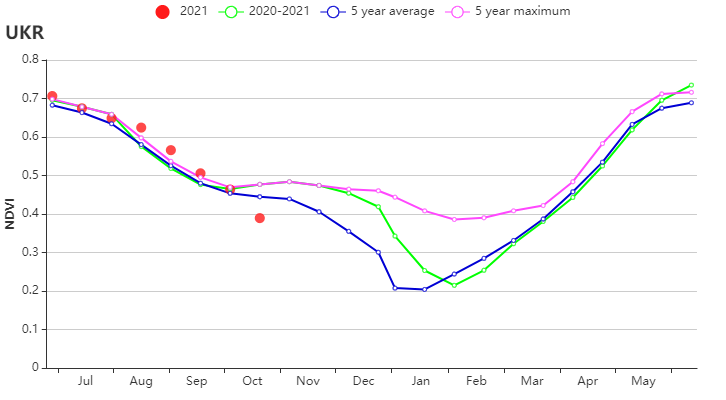
(b) 基于 NDVI 的作物生长过程线

(c) 最佳植被状况指数

(d)NDVI 距平空间聚类图(与 5 年平均相比) (e) NDVI 距平聚类过程线
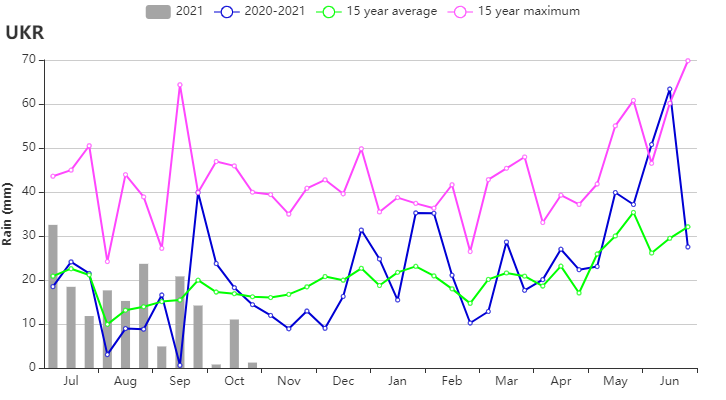
(f) 累计降水过程线
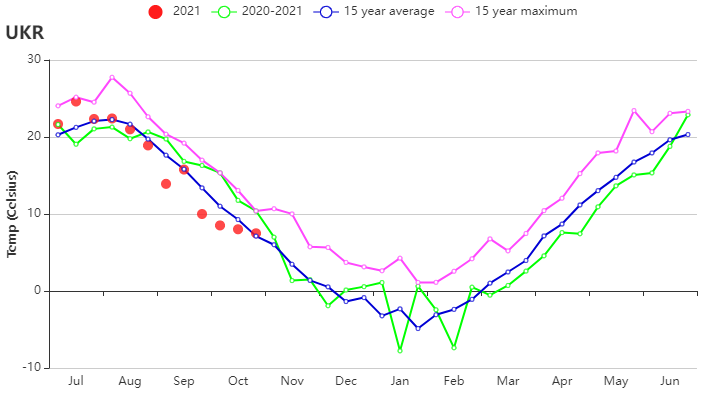
(g) 平均温度过程线

(h) 基于 NDVI 的作物生长过程线(中部小麦产区)
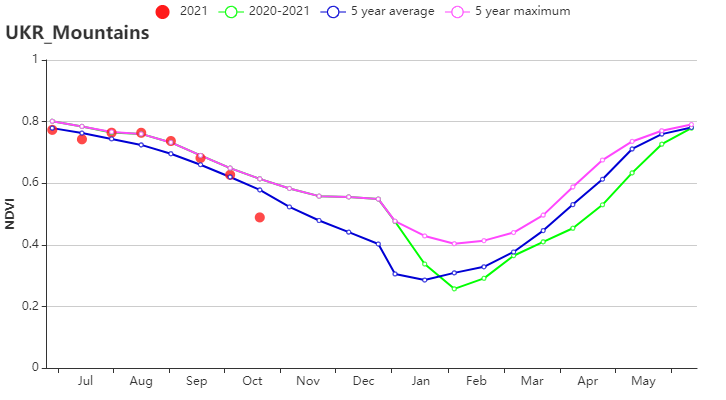
(i) 基于NDVI 的作物生长过程线(东喀尔巴阡山地区)

(j) 基于NDVI 的作物生长过程线(北部小麦产区)

(k) 基于NDVI 的作物生长过程线(南部小麦和玉米产区)

(l) 2021年7-10月乌克兰不同旱情等级发生面积占比变化图
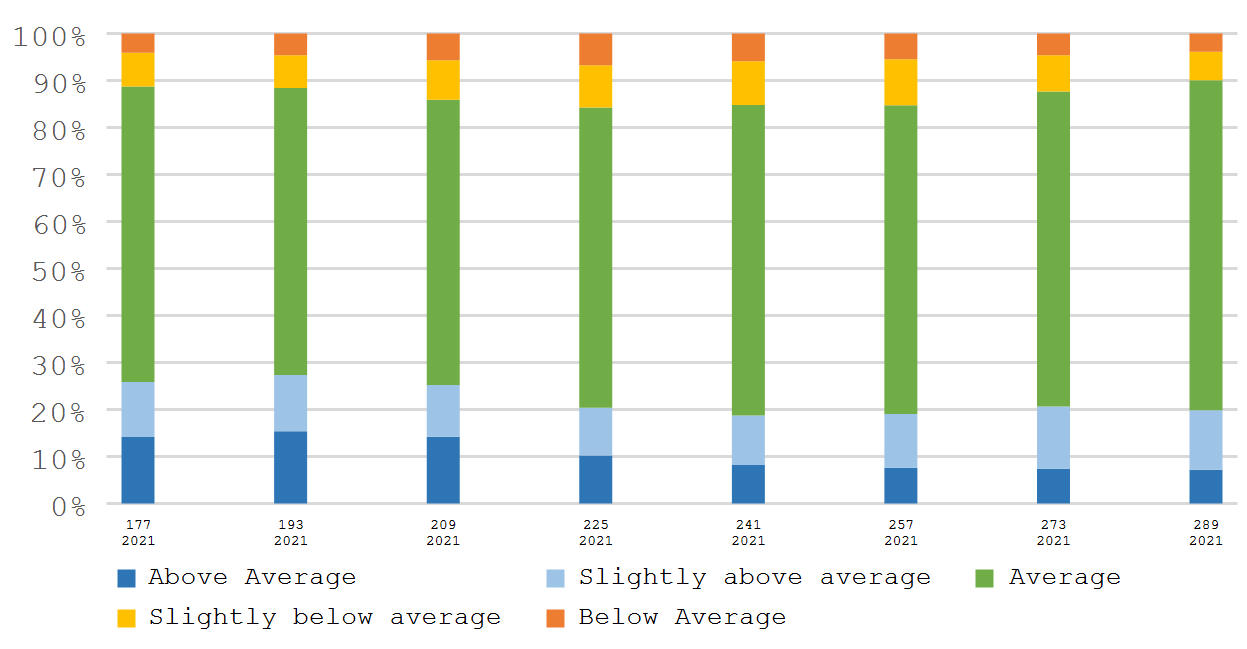
(l) 2021年7-10月乌克兰最小植被健康指数面积占比变化图
表3.73 乌克兰农业生态分区2021年7-10月与过去15年(15YA)同期农业气象指标
| 累积降水 | 平均温度 | 光合有效辐射 | 潜在生物量 | |||||
| 分区 | 当前值 (mm) | 距平 (%) | 当前值 (°C) | 距平 (°C) | 当前值 (MJ/m2) | 距平 (%) | 当前值 (gDM/m2) | 距平 (%) |
| 中部小麦产区 | 153 | -17 | 16.1 | -0.6 | 995 | 5 | 601 | -3 |
| 东喀尔巴阡山地区 | 189 | -33 | 14.5 | -0.5 | 968 | 1 | 599 | -19 |
| 北部小麦产区 | 185 | -19 | 15.2 | -0.4 | 936 | 5 | 619 | -7 |
| 南部小麦和玉米产区 | 152 | -4 | 17.8 | -0.7 | 1045 | 3 | 598 | 0 |
表3.74 乌克兰农业生态分区2021年7-10月与近5年(5YA)同期农情指标
| 耕地种植比例 | 最佳植被状况指数 | ||
| 分区 | 当前值 | 距平 (%) | 当前值 |
| 中部小麦产区 | 53 | -22 | 0.71 |
| 东喀尔巴阡山地区 | 67 | -28 | 0.69 |
| 北部小麦产区 | 57 | -26 | 0.72 |
| 南部小麦和玉米产区 | 68 | -16 | 0.75 |
